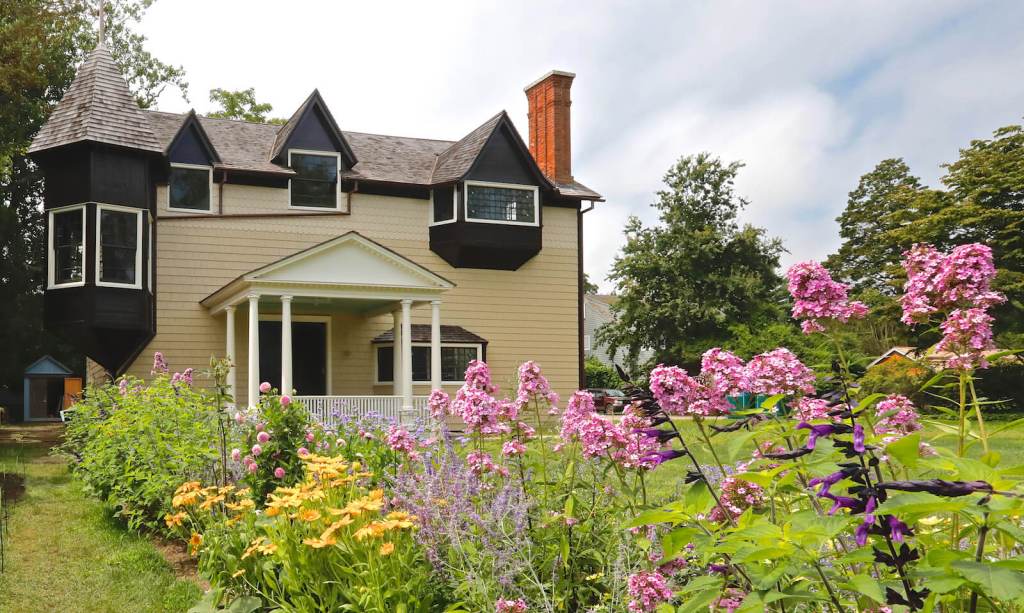Most passers-by to the old turreted house facing the pond in East Hampton don’t realize how revolutionary it was, even though the eccentric, eclectic building, with its sea-monster weathervane, is eye-catching. Nor how important a part in American art–even in American history–its original owners played.
The Thomas Moran House and Studio was built in 1884 on Main Street in East Hampton, opposite Town Pond. Its owners, Thomas and Mary Nimmo Moran, were important painters and engravers, and this house was the first artist’s studio on the East End. Thomas Moran’s paintings of the West, especially Yellowstone and the Grand Canyon, are often credited with inspiring the creation of the National Park Service. He also painted and engraved local East Hampton scenes, as did his wife.
Moran, born in 1837, began his career as an apprentice engraver. In 1862, he traveled to England to see the work of J.M.W. Turner, whose use of color and choice of landscape influenced his own work greatly. (Hanging over the fireplace at the Moran house was a copy Moran made of the Turner painting “Ulysses Deriding Polyphemus — Homer’s Odyssey,” which now hangs across the pond at the Hedges Inn.) Moran was appointed chief illustrator at Scribner’s Monthly in the late 1860s, which helped launch his painting career.
In 1871, the director of the United States Geological Survey invited Moran along as part of an expedition to the unknown Yellowstone region, which was partially funded by Scribner’s. In 40 days in the wilderness, Moran sketched more than 30 geological wonders. His sketches captivated the nation; the next year, Congress established Yellowstone as the first national park.
Moran married his Scottish-born student Mary Nimmo in 1865. Because of sexism, Mary signed her work MNMoran, rather than her full name. She too became renowned for her prints. In 1881 she became the first female fellow of London’s Royal Society of Painters-Etchers.
The Morans purchased land in East Hampton and began construction of their home in 1884. Moran designed the house himself, setting aside much of the ground floor as a studio. His quirky practices included re-using material from demolished houses. At the time, Manhattan was experiencing a building boom, where older houses were being knocked down to build fashionable brownstones.
The larger window in the studio room came from a candy store. At the time, a large piece of sheet glass was very expensive. The front doors to the studio also came from that store, while the fireplace surrounds came from two houses: a Federal one, circa 1800, and a Greek Revival circa 1825. Other pieces, such as cabinet doors, other windows and newel posts for the staircase, also obviously came as architectural salvage. (One elaborately carved baluster, Thomas Moran Trust curator Richard Barons says, was found painted gold and being used as a lamp base. It’s now back in the staircase.) Moran even imported a gondola from Italy, which his daughters used on Town Pond. The house originally did not boast a kitchen, as the Morans simply walked to a local boardinghouse for meals. A later one-story addition is now painted blue, as it was in 1899.
The house became a hub for intellectuals and artists in the area during the five or six months per year that the Morans were in residence. Parties and tableaux vivants were features of social life.
Unfortunately, Mary died of typhoid young, in 1899. Moran himself continued to stay at the house and studio until his death in 1926. They are both buried in South Side Cemetery. Daughter Ruth inherited the house; she sold it in 1947 to Joseph and Elizabeth Condie Lamb. (Mrs. Condie Lamb was well known for running the oldest real estate agency in East Hampton.) After Mrs. Lamb’s death in 2004, Guild Hall took possession of the house, now considerably dilapidated.
The decision was made by Guild Hall to transfer ownership of the Studio to the newly created Thomas Moran Trust, which would restore the property. But money was lacking. After Superstorm Sandy in 2012 badly damaged the house, the need the do the work took on more urgency. The house rocked on its pier foundations during the storm, says Barons, and many people thought the house should be taken apart and then rebuilt.
The house was raised up off its brick plinths and a foundation laid, then the brick plinths were rebuilt. (A piece of paper was found in one, attesting that the house had been completed in September 1884.) Worries that the house would collapse proved unfounded.
Twelve years of fundraising, conservation easements and a CPF grant later, the restoration of the house is complete. And not just of the house: the beautiful garden that Mary Nimmo doted over has been restored as well.
The interior is filled with objects that the Morans owned, such as Thomas’s palette, as well as those similar to what they would have owned. (The Morans’ own furniture was scattered after their deaths.) Old carpets are draped over a railing and Aesthetic Movement bits of china and Japanese fans decorate odd shelves. (The Aesthetic Movement was the popular style among the intellectuals of the 1880s.)
Of course, the crown jewels of the house are the paintings and etchings by Thomas and Mary. Some are of local scenes, with the familiar windmills of East Hampton, while others are of Western landscapes. Many of the Western landscapes were painted right in the studio, with Moran working off sketches and photographs of the area. The artwork comes from various collections, including the Moran Trust, the East Hampton Historical Society and the East Hampton Library.
The artworks line the walls of the studio and other exhibition rooms. The master bedroom, with its bed topped with pineapple-carved knobs and its leopard skin rug, is the only bedroom that will be restored as a sleeping chamber. Other rooms are exhibition space. Downstairs, for example, is displayed a huge iron 1860s etching press.
Now that the Studio is open for tours, it is greatly to be hoped that more passers-by will stop to learn about this fascinating house and its important owners.























